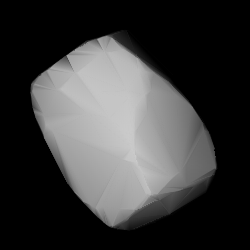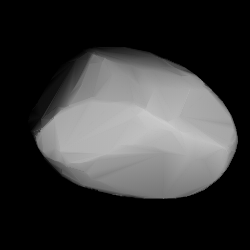
2985 Shakespeare (prov. designation: 1983 TV1) is a stony Koronian asteroid from the outer region of the asteroid belt. It was discovered on 12 October 1983, by American astronomer Edward Bowell at Lowell's Anderson Mesa Station near Flagstaff, Arizona, and later named after William Shakespeare. The presumed S-type asteroid has a rotation period of 6.1 hours and measures approximately 10 kilometers (6.2 miles) in diameter.

158 Koronis is a main-belt asteroid that was discovered by Russian astronomer Viktor Knorre on January 4, 1876, from the Berlin observatory. It was the first of his four asteroid discoveries. The meaning of the asteroid name is uncertain, but it may come from Coronis the mother of Asclepius from Greek mythology. Alternatively, it may come from Coronis, a nymph of the Hyades sisterhood. The Koronis family is named after this asteroid.

277 Elvira is a typical main belt asteroid and is a member of the Koronis asteroid family. It was discovered by Auguste Charlois on 3 May 1888 in Nice. 277 Elvira is possibly named for a character in Alphonse de Lamartine's Méditations poétiques (1820) and Harmonies poétiques et religieuses (1830).

321 Florentina is an S-type (stony) main belt asteroid with a diameter of 28 km. It was discovered by Johann Palisa on 15 October 1891 in Vienna. He named the asteroid for his daughter, Florentine. Between 1874 and 1923, Palisa discovered a total of 122 asteroids.

377 Campania is a large main belt asteroid that was discovered by French astronomer Auguste Charlois on 20 September 1893 in Nice.

462 Eriphyla is a Koronian asteroid from the outer regions of the asteroid belt. It was discovered by German astronomer Max Wolf at the Heidelberg-Königstuhl State Observatory on 22 October 1900. The stony S-type asteroid has a rotation period of 8.7 hours and measures approximately 35 kilometers in diameter. It was named after Eriphyle, from Greek mythology.
678 Fredegundis is a minor planet orbiting the Sun. It was discovered 22 January 1909 from Heidelberg by German astronomer K. Wilhelm Lorenz, and was named after the French opera Frédégonde. This object is orbiting at a distance of 2.57 AU with a period of 4.13 years and an eccentricity (ovalness) of 0.22. The orbital plane is inclined at an angle of 6.1° to the plane of the ecliptic

720 Bohlinia is a minor planet orbiting the Sun that was discovered by Franz Kaiser, a German astronomer in 1911. It is named for Swedish astronomer Karl Petrus Theodor Bohlin, to mark his 65th birthday. He had worked on the orbits of asteroids.

838 Seraphina is a dark and large background asteroid, approximately 58 kilometers in diameter, located in the outer regions of the asteroid belt. It was discovered by German astronomer Max Wolf at the Heidelberg-Königstuhl State Observatory on 24 September 1916. The primitive P-type asteroid has a rotation period of 15.7 hours and is rather spherical in shape. Any reference to the origin of the asteroid's name is unknown.
1955 McMath, provisional designation 1963 SR, is a stony Koronis asteroid from the outer region of the asteroid belt, approximately 10 kilometers in diameter.

1029 La Plata, provisional designation 1924 RK, is a stony Koronis asteroid from the outer regions of the asteroid belt, approximately 20 kilometers in diameter. It was discovered on 28 April 1924, by German astronomer Johannes Hartmann at the La Plata Astronomical Observatory in Argentina. It was named after the city of La Plata, Argentina, where the discovering observatory is located. The possibly elongated S-type asteroid has a rotation period of 15.31 hours.
1079 Mimosa, provisional designation 1927 AD, is a stony Karin or Koronian asteroid from the outer regions of the asteroid belt, approximately 20 kilometers in diameter. It was discovered on 14 January 1927, by Belgian–American astronomer George Van Biesbroeck at the Yerkes Observatory in Williams Bay, Wisconsin. The asteroid was named after the flowering plant Mimosa.
1100 Arnica, provisional designation 1928 SD, is a Koronian asteroid from the outer regions of the asteroid belt, approximately 17 kilometers in diameter. It was discovered by Karl Reinmuth at the Heidelberg Observatory in 1928 and named after the herbaceous plant Arnica. The asteroid is likely of stony composition and has a rotation period of 14.535 hours.

1223 Neckar, provisional designation 1931 TG, is a stony Koronian asteroid from the outer region of the asteroid belt, approximately 25 kilometers in diameter. Discovered by Karl Reinmuth at Heidelberg Observatory in 1931, the asteroid was named for the German river Neckar. The S-type asteroid has a rotation period of 7.8 hours.

1635 Bohrmann, provisional designation 1924 QW, is a stony Koronian asteroid from the outer region of the asteroid belt, approximately 17 kilometers in diameter. It was discovered on 7 March 1924, by German astronomer Karl Reinmuth at Heidelberg Observatory in southern Germany, and named for astronomer Alfred Bohrmann.

1848 Delvaux is a stony Koronis asteroid from the outer region of the asteroid belt, approximately 17 kilometers in diameter. It was discovered on 18 August 1933, by Belgian astronomer Eugène Delporte at the Royal Observatory of Belgium in Uccle, Belgium. It was later named after astronomer Georges Roland's sister-in-law.

1423 Jose, provisional designation 1936 QM, is a stony asteroid of the Koronis family from the outer regions of the asteroid belt, approximately 20 kilometers in diameter. It was discovered on 28 August 1936, by Belgian astronomer Joseph Hunaerts at the Royal Observatory of Belgium in Uccle. The elongated S-type asteroid has a rotation period of 12.3 hours. It was named for Giuseppina, daughter of Italian astronomer Giuseppe Bianchi.
2726 Kotelnikov, provisional designation 1979 SE9, is a stony Koronian asteroid from the outer regions of the asteroid belt, approximately 10 kilometers (6.2 miles) in diameter. It was discovered on 22 September 1979, by Soviet astronomer Nikolai Chernykh at the Crimean Astrophysical Observatory in Nauchnij on the Crimean peninsula. The S-type asteroid has a rotation period of 4.91 hours and is a suspected binary system. The asteroid was named for Soviet scientist and pioneer in radar astronomy, Vladimir Kotelnikov.

1389 Onnie, provisional designation 1935 SS1, is a stony Koronian asteroid from the outer region of the asteroid belt, approximately 13 kilometers in diameter. It was discovered on 28 September 1935, by Dutch astronomer Hendrik van Gent at Leiden Southern Station, annex to the Johannesburg Observatory in South Africa.

1289 Kutaïssi is a stony Koronian asteroid from the outer region of the asteroid belt. Discovered by Grigory Neujmin at Simeiz Observatory in 1933, it was later named after the Georgian city of Kutaisi. The S-type asteroid has a rotation period of 3.6 hours and measures approximately 22 kilometers in diameter.















